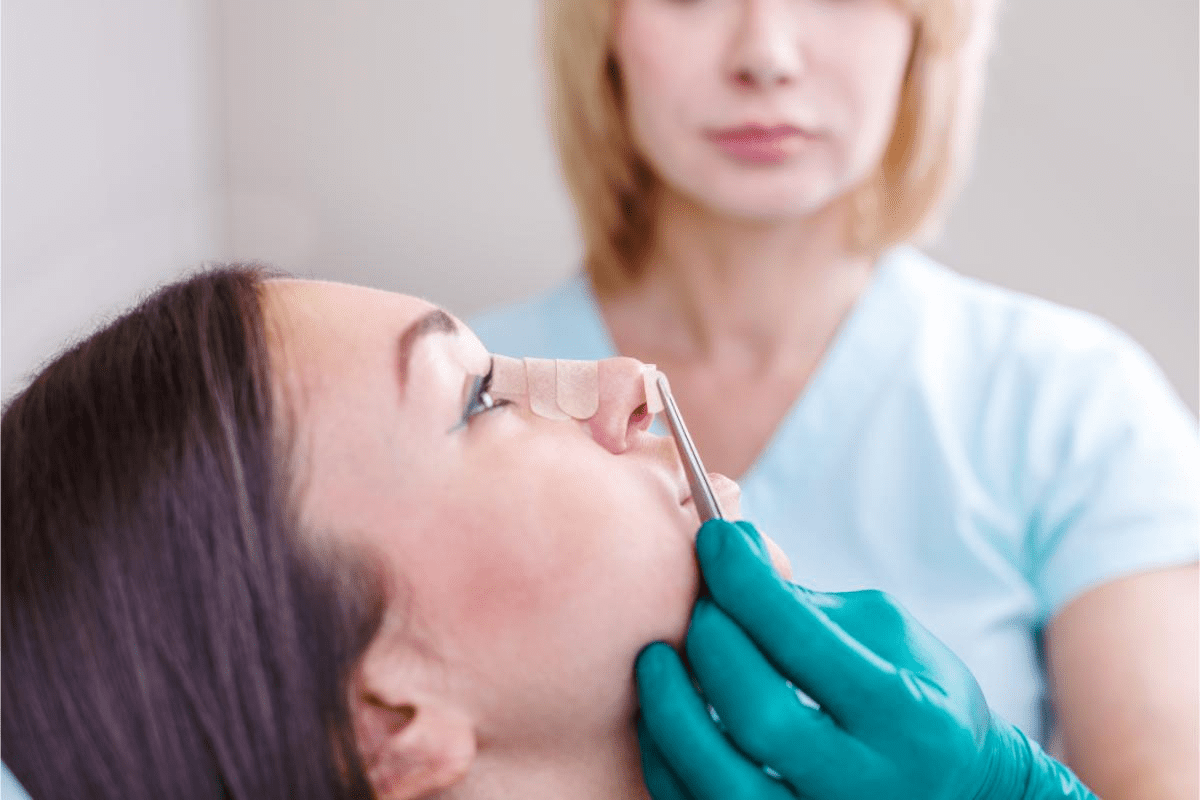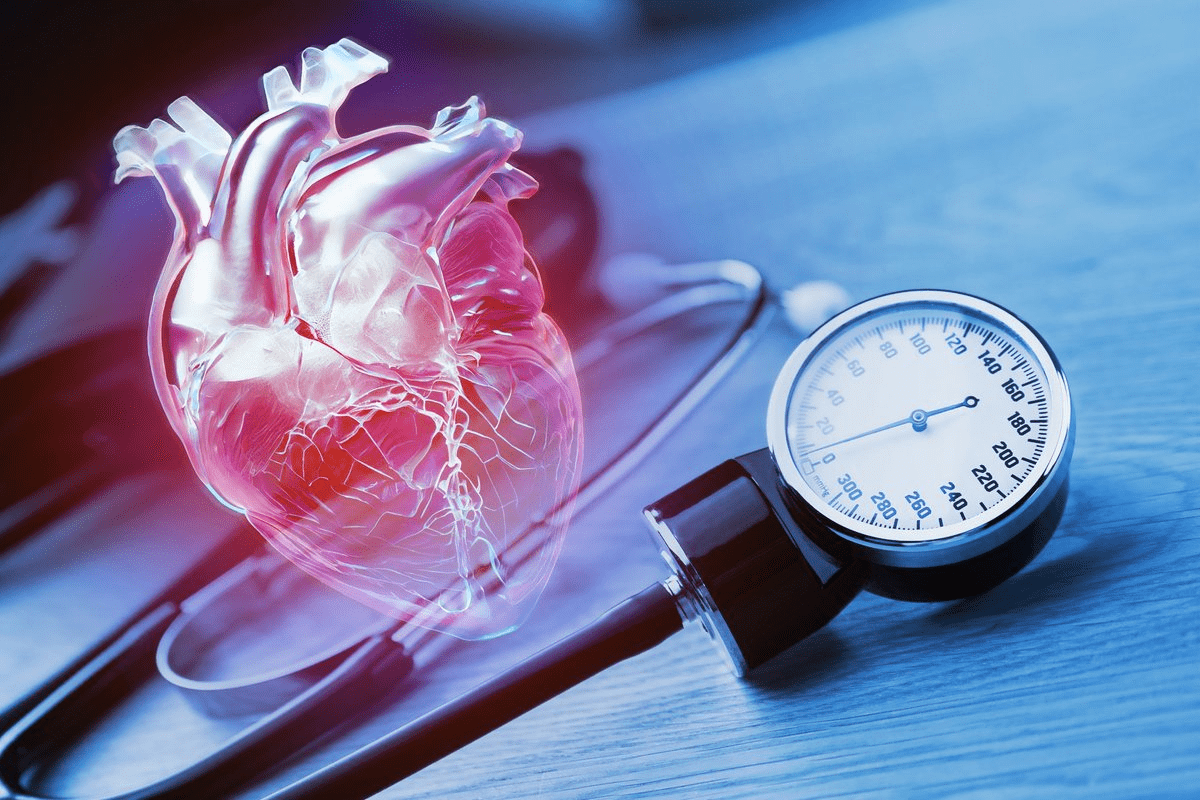Last Updated on November 27, 2025 by Bilal Hasdemir
What is the pinch test for breasts? Gynecomastia is when men’s breast tissue gets bigger. It happens to a lot of guys. Knowing the signs and how to check for it is key to catching it early. The pinch test is a simple way to do this.
To do the pinch test, you gently squeeze the nipple and the area around it. This helps find glandular tissue. It’s a way to see if hormonal imbalances or health issues might be causing it.
Key Takeaways
- The pinch test is a simple self-examination for gynecomastia.
- It involves pinching the nipple and surrounding area to check for glandular tissue.
- Early detection through the pinch test can aid in the management of gynecomastia.
- Gynecomastia can be caused by hormonal imbalances or other underlying health conditions.
- Understanding the pinch test is important for breast health awareness.
Understanding Gynecomastia: Definition and Overview

Gynecomastia is when men grow breast tissue. It can happen to men of any age. It’s often linked to hormonal imbalances.
What Exactly is Gynecomastia?
Gynecomastia is when men’s breast tissue grows. It can happen in one or both breasts. It feels firm or tender under the nipple.
This usually happens because of an estrogen and testosterone imbalance. Symptoms include swelling or tenderness in the breast area. It can also cause emotional distress or body image issues.
Prevalence and Demographics
Gynecomastia can affect men at any age, from babies to seniors. Its frequency varies by age group. Puberty is a common time for it, as hormones change a lot.
| Age Group | Prevalence of Gynecomastia |
| Infancy | 60-90% |
| Puberty | 50-60% |
| Adulthood | 30-40% |
Knowing about gynecomastia’s prevalence helps spot symptoms early. It’s important to understand its impact on different age groups. This way, people can recognize it in themselves or others.
Identifying Gyno Nipples: Characteristics and Symptoms
Understanding gyno nipples means knowing the visual and physical signs of gynecomastia. Gynecomastia is when men’s breast tissue gets bigger. It shows in different ways.
Visual Signs of Gynecomastia
Signs of gynecomastia include swelling or enlargement of the breast tissue. This can happen on one side or both. The swelling might also change the look of the nipple-areola complex.
In some cases, the swelling is small. It might only be seen when you look closely or touch it.
Physical Sensations and Discomfort
People with gynecomastia might feel tenderness or sensitivity in their nipples or breasts. These feelings can be strong or weak. They might be there all the time or come and go.
The pain or discomfort can really bother someone. Knowing these signs is key to catching it early. It helps tell it apart from other issues like pseudogynecomastia, where fat builds up but not glandular tissue.
The Pinch Test for Gynecomastia: Step-by-Step Guide
Understanding gynecomastia starts with a simple self-check called the pinch test. This test helps people find out if they have glandular tissue. This is a key sign of gynecomastia.
Proper Technique for the Breast Pinch Test
To do the breast pinch test right, follow these steps:
- Gently pinch the skin and tissue around the nipple with your thumb and index finger.
- Make sure you pinch enough to feel accurately.
- Avoid pinching too hard to avoid discomfort.
What You Should Feel During the Test
When doing the pinch test for gynecomastia, notice the texture of the tissue. If it feels firm or rubbery, it might mean you have glandular tissue. This suggests gynecomastia. It’s important to be gentle and patient for accurate results.
Common Mistakes When Performing the Test
When doing the gynecomastia pinch test, avoid these common mistakes:
- Don’t pinch too hard to avoid discomfort.
- Pinch enough tissue to get accurate results.
- Relax during the test to get better results.
By using the right technique and knowing these mistakes, you can use the pinch test well. If you’re unsure or feel discomfort, see a healthcare professional for help.
Interpreting Pinch Test Results
Getting the pinch test right is key to spotting gynecomastia and telling it apart from other issues. The test’s findings are vital for figuring out what to do next about breast tissue problems.
Positive Signs of Glandular Tissue
A positive pinch test usually means you have glandular tissue, a main sign of gynecomastia. This tissue feels firm or rubbery under the nipple-areola area. It’s different from the softer, fatty tissue found in pseudogynecomastia.
Having glandular tissue is a big clue for true gynecomastia. It’s harder to pinch and stands out from the fatty tissue around it.
Negative Results and What They Mean
A negative test means no glandular tissue was found, suggesting mostly fat in the breast. This is called pseudogynecomastia. The tissue feels softer, like the fat around it.
Knowing what a negative result means is important. It might mean the issue is just fat, not gland growth. But, it’s always best to see a doctor to check for any health problems.
True Gynecomastia vs. Pseudogynecomastia
Gynecomastia can be divided into two types: true gynecomastia and pseudogynecomastia. Each has its own features. Knowing these differences is key for men with breast tenderness or growth.
Glandular Tissue vs. Fat Deposits
True gynecomastia involves glandular breast tissue due to hormonal imbalances. This can make the breast tender and bigger. Pseudogynecomastia, on the other hand, is about fat deposits in the breast area without glandular tissue. Both can make breasts look bigger, but their causes and signs are different.
Glandular tissue in true gynecomastia can be painful and may need medical help. Pseudogynecomastia, linked to body fat, can be managed with weight loss and lifestyle changes.
Differential Diagnosis Methods
Telling true gynecomastia from pseudogynecomastia is key for right treatment. Differential diagnosis methods include physical checks, imaging like mammography or ultrasound, and sometimes biopsy. These steps help doctors figure out what’s in the breast, guiding treatment.
A healthcare provider might do a breast pinch test or other checks during a physical exam. Imaging studies can show the breast’s internal details.
Getting the right diagnosis is vital for choosing the best treatment. This could mean fixing hormonal issues, changing lifestyle, or surgery.
Additional Self-Assessment Methods Beyond the Pinch Test
There are more ways to check for gynecomastia than just the pinch test. Visual and palpation techniques offer a deeper look at breast health. Together, they help understand the body better.
Visual Mirror Examination
Looking in the mirror can show signs of breast changes. Here’s how to do it right:
- Stand in front of a mirror with your torso exposed.
- Observe the chest area from multiple angles.
- Look for any swelling, enlargement, or unevenness.
Palpation Techniques
Palpation means feeling the breast with your fingers. It helps find lumps or odd spots. Here’s how to do it:
- Lie down on a flat surface.
- Using the pads of your fingers, gently press the breast tissue in a circular motion.
- Check for any firm or tender areas.
The table below shows the main differences between looking in the mirror and palpation:
| Method | Purpose | Key Actions |
| Visual Mirror Examination | Identify visible signs of gynecomastia | Observe chest area from multiple angles, look for swelling or asymmetry |
| Palpation Techniques | Detect lumps or abnormalities in breast tissue | Lie down, press breast tissue in a circular motion, check for firm or tender areas |
Using these methods together helps people understand their breast health better. It also helps them decide when to see a doctor.
Stages of Gynecomastia Development
Gynecomastia is a complex process with several stages. It starts with breast tissue growth and can get more serious. It’s important for men to know the stages to get the right medical help.
Early Signs and Stage 1
In the early stages, men might feel a small, tender lump under their nipple. This lump can hurt when touched or pressed. At this point, the condition can often be treated and reversed.
Early-stage gynecomastia signs include:
- Mild breast tenderness
- Small, firm lump under the nipple
- Possible pain or discomfort when touched
Advanced Stages and Progression
As gynecomastia gets worse, the breast tissue grows more. This can make symptoms more severe. In later stages, treatment might need to be more serious, like surgery.
Many things can make gynecomastia get worse. These include hormonal imbalances, some medicines, and health problems.
| Stage | Characteristics | Treatment Options |
| Early Stage | Mild breast tenderness, small lump | Monitoring, medication |
| Advanced Stage | Pronounced breast growth, possible pain | Surgical intervention, hormone therapy |
Common Causes of Gyno Nipples and Breast Tissue in Men
It’s important to know why gynecomastia happens. This condition, where men grow breast tissue, can come from many sources. These include hormonal imbalances, some medicines, and health issues.
Hormonal Imbalances
Hormonal imbalances are a big reason for gynecomastia. Estrogen makes breast tissue grow, while testosterone stops it. If these hormones get out of balance, men can grow breast tissue.
Medications and Substances
Some medicines and substances can also cause gynecomastia. These include:
- Anabolic steroids
- Some antibiotics
- Anti-ulcer medications
- Drugs for high blood pressure and heart issues
- Substances in some recreational drugs
Talk to your doctor if you’re taking these and notice gynecomastia symptoms.
Health Conditions
Many health problems can lead to gynecomastia. These include:
| Condition | Description |
| Liver Disease | Liver problems can mess with hormone levels. |
| Kidney Disease | Some kidney issues can affect hormone levels. |
| Thyroid Disorders | Too much thyroid hormone can cause gynecomastia. |
| Tumors | Tumors in hormone-making glands can cause gynecomastia. |
Professional Diagnosis of Gynecomastia
Getting a professional diagnosis is key to figuring out gynecomastia. A detailed medical check-up is the first step to tackle this issue.
Medical Examination Procedures
A healthcare provider will start with a detailed medical history and physical check-up. They will look at the breast tissue and check for any oddities. They also assess your overall health.
The medical history involves asking about symptoms, health issues, medicines, and lifestyle. The physical check-up focuses on the breast, looking for glandular tissue and how much it’s enlarged.
Diagnostic Tests and Imaging
To confirm the diagnosis and rule out other issues, tests and imaging might be needed. These include:
- Mammography to look closely at the breast tissue
- Ultrasound to check the breast tissue’s makeup
- Blood tests to check hormone levels and find any imbalances
Imaging studies like mammography and ultrasound are vital. They help tell glandular from fatty tissue, confirming gynecomastia.
Medical experts say, “A detailed diagnosis is essential for planning treatment.” A thorough diagnosis finds the cause of gynecomastia, guiding the right treatment.
“Accurate diagnosis is the cornerstone of effective management of gynecomastia, allowing for targeted treatment approaches.”
” Medical Expert
Treatment Options for Gynecomastia
The treatment for gynecomastia depends on several things. These include the cause and the person’s health. Knowing the treatment options is key to making good choices about managing the condition.
Non-Surgical Approaches
For many, the first step is non-surgical treatments. These can include:
- Addressing underlying hormonal imbalances: Medications or supplements may be prescribed to correct hormonal issues contributing to gynecomastia.
- Lifestyle changes: Changes in diet and exercise can help reduce body fat, which may contribute to the appearance of gynecomastia.
- Discontinuing contributing medications: If a medication is identified as a cause, stopping or replacing it may help alleviate symptoms.
These non-surgical methods are often first because they are less invasive. They can be effective for mild cases or when the condition is caused by factors that can be reversed or managed.
Surgical Interventions
For more severe cases or when non-surgical approaches fail, surgery may be considered. The main surgical option is mastectomy. This involves removing the breast glandular tissue.
Surgery is usually recommended when:
- The condition is long-standing and causes significant distress.
- Non-surgical treatments have been tried without success.
- The individual is experiencing pain or discomfort due to gynecomastia.
It’s vital to talk to a healthcare professional to find the best treatment plan. They can assess the condition, discuss the benefits and risks of treatments, and help make a decision.
Gynecomastia in Athletes and Bodybuilders
Anabolic steroids and other substances can lead to gynecomastia in athletes. This condition makes breast tissue grow in men. It affects their mental and physical health.
The Link Between Anabolic Steroids and Gynecomastia
Using anabolic steroids can cause gynecomastia. These substances upset the body’s hormonal balance. This leads to more estrogen, causing breast tissue to grow.
Anabolic steroids turn into estrogen through an enzyme called aromatase. This imbalance favors estrogen over testosterone. It promotes gynecomastia.
Key factors contributing to gynecomastia in athletes using anabolic steroids include:
- The type and dosage of anabolic steroids used
- The duration of steroid use
- Individual susceptibility to hormonal imbalances
Prevention Strategies for Athletes
Preventing gynecomastia requires a few steps. Avoiding anabolic steroids and substances that upset hormonal balances is key.
| Prevention Strategy | Description |
| Avoid Anabolic Steroids | Not using anabolic steroids is the best way to avoid gynecomastia. |
| Maintain a Healthy Lifestyle | Eating well, exercising, and keeping a healthy weight helps prevent hormonal imbalances. |
| Be Aware of Supplement Risks | Some supplements can upset hormones. Athletes should research them before using. |
Knowing the risks of anabolic steroids and using prevention strategies can help athletes avoid gynecomastia.
When to Seek Medical Attention
If you notice symptoms of gynecomastia, it’s important to know when to see a doctor. Gynecomastia is when men’s breast tissue gets bigger. It can be uncomfortable and worrying. Knowing when to go to a healthcare provider is key.
Warning Signs and Red Flags
There are signs that mean you should see a doctor for gynecomastia. These include:
- Persistent or worsening symptoms: If your symptoms keep getting worse, it’s time to see a doctor.
- Pain or tenderness: Feeling pain or tenderness in your breasts is a warning sign.
- Significant asymmetry: If your breasts are noticeably different in size or shape, you should get checked.
- Nipple discharge: Nipple discharge can be a sign of gynecomastia or another issue that needs a doctor’s look.
Choosing the Right Healthcare Provider
Choosing the right doctor is important when you decide to see one. Consider these points:
- Specialization: Find a doctor who knows about endocrinology or has experience with gynecomastia.
- Referrals: Ask your primary care doctor or other healthcare professionals for recommendations.
- Patient reviews: Look at what other patients say to learn about a doctor’s skills and how they treat patients.
Choosing a qualified doctor means you’ll get the right care for your gynecomastia.
Conclusion
Understanding gynecomastia is key for those dealing with it. Recognizing signs like the pinch test can lead to medical help. This is the first step towards addressing health concerns.
A summary of gynecomastia shows it’s complex. It involves hormonal imbalances and health issues. Knowing this helps in finding the right treatment.
Talking about gynecomastia, it’s important to know it can be treated. There are many ways to tackle it, from non-surgical to surgical methods. Getting advice from a doctor is the best way to choose the right treatment.
Being informed and taking action can help manage gynecomastia. This approach improves overall health and well-being.
FAQ
What is the pinch test for breasts?
The pinch test is a simple way to check for gynecomastia. It involves gently pinching the nipple and the area around it. This helps feel for glandular tissue.
What is gynecomastia?
Gynecomastia is when men grow breast tissue. It happens when estrogen and testosterone levels get out of balance. This can make one or both breasts swell and feel firm or tender.
How do I identify gyno nipples?
Look for swelling or enlargement of breast tissue. Also, check for tenderness or sensitivity in the nipple or breast area. These are signs of gynecomastia.
How do I perform the pinch test for gynecomastia?
To do the pinch test, pinch the skin and tissue around the nipple. Use your thumb and index finger. If it feels firm or rubbery, it might be glandular tissue, showing gynecomastia.
What does a positive pinch test result mean?
A positive test means you have gynecomastia. This is because you have glandular tissue in your breast. It’s important to see a doctor about it.
What is the difference between true gynecomastia and pseudogynecomastia?
True gynecomastia has glandular breast tissue, often from hormonal imbalances. Pseudogynecomastia, on the other hand, is fat in the breast area without glandular tissue.
Are there other self-assessment methods for checking gynecomastia?
Yes, you can also use a mirror to look for breast enlargement or asymmetry. Or, you can use palpation to feel for lumps or abnormalities in the breast tissue.
What are the stages of gynecomastia development?
Gynecomastia goes through stages, from the first signs of breast tissue growth to more noticeable stages. Catching it early is key to managing it effectively.
What causes gynecomastia?
Gynecomastia can be caused by hormonal imbalances, certain medications, or health issues like liver or kidney disease. It can also be caused by thyroid disorders or tumors.
How is gynecomastia diagnosed professionally?
Doctors diagnose gynecomastia with a detailed medical exam, including a history and physical check. They might also do tests like mammography, ultrasound, or blood tests to check hormone levels.
What are the treatment options for gynecomastia?
Treatment varies based on the cause, severity, and health. It can include non-surgical methods like fixing hormonal imbalances or changing your lifestyle. For severe cases, surgery like mastectomy might be needed.
Why is gynecomastia a concern for athletes and bodybuilders?
Athletes and bodybuilders using anabolic steroids face a risk of gynecomastia. These substances can mess with hormone levels. Staying away from these substances and living a healthy lifestyle can help prevent it.
When should I seek medical attention for gynecomastia?
If symptoms don’t go away or get worse, seek medical help. Look for pain or significant differences in breast size. It’s important to choose the right doctor, like an endocrinologist, for proper care.






